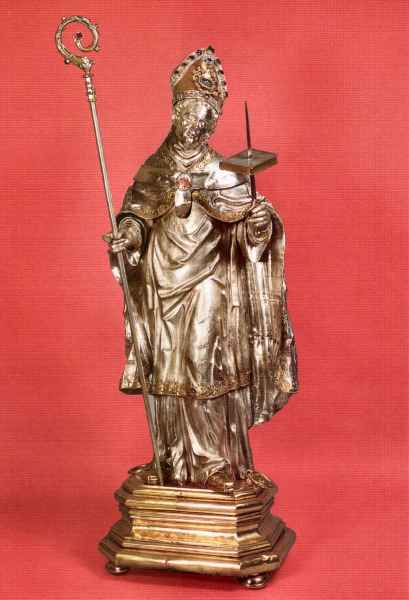St. Boniface. Silver statue, partly goldplated, by
Johann Zeckel. Augsburg 1716, Fulda Cathedral Collection
A Souvenir of your Visit to the Tomb of Saint
Boniface
You are here at the burial place of St. Boniface, apostle to the
Germans. Following his martyr's death on June 5, 754 in Dokkum, North
Friesland, he was buried on July 5, 754 in Fulda. A non-Catholic
historian said of him: "Everything that has since developed politically,
theologically, and intellectually in Germany stands on the foundation
that Boniface laid. Boniface' grave in Fulda must be holier to us than
the graves of the patriarchs were to the Israelites, for he is the
intellectual father of our people. Boniface has given to us and to our
grandchildren more than any of our great emperors and kings could."
(Heinrich Leo, Readings on German History I, pp. 487-8).
Who was he?
Born about 675 in Crediton, near the south coast of England, and baptized
Winfried, he entered the Benedictine monastery at Nursling, becoming a
monk and priest. A strong missionary zeal never left this young man.
Finally in 716 the Abbot gave him permission to work in the missions of
Friesland, where the missionary Willibrord had been working for some
years. But the turmoil of war and the ill will of the heathen Friesians
left Wilfried unsuccessful. After some months he returned to his
monastery for two more years of preparation. In 718 he departed again,
never to return. He traveled to Rome to ask the Holy Father for his
commission and blessing. On May 14, 719 Winfried knelt at the feet of
Pope Gregory II. This was the day the Roman church celebrated the feast
of the holy martyr Boniface. Gregory II renamed the Benedictine monk
Winfried accordingly; from this day on this missionary of the Pope bore
the name Boniface.
He crossed the Alps and began his missionary work in Thuringia but
returned to Friesland to see Willibrord; in 721 he went to Hesse, and was
called back to Rome in 722 to be consecrated a regional bishop on
November 30. In 723 he felled the oak of Donar and in 725 returned to
Thuringia. He stayed in continuous touch by mail with Rome and England.
Gregory III made him an archbishop. In 738 on his third trip to Rome he
was named papal legate to France, founded dioceses (Büraberg,
Erfurt, and Würzburg), organized the dioceses in Bavaria and
provided good bishops, taking upon himself the see of Mainz, and held
many church councils with the rulers of France.
Through his student Sturmius he founded the monastery of Fulda in 744; it
was his favorite, he went back there to rest (Bischofsberg, now
Frauenberg) and designated Fulda for his burial.
When he was nearly eighty he was dawn back once again to Friesland, to
the place of his first apostolic work, where on Pentecost Sunday, June 5,
754 he was killed along with fifty-two companions. Both Utrecht and Mainz
wanted to enshrine the saint's body, but the Martyr's last wish, to be
buried at Fulda, was fulfilled on July 9, 754.
The quiet tomb in the crypt of the Fulda cathedral, which was built in
the years 1704-1712, preserves the saint's remains. This is the goal of
many pilgrims, and for one hundred years (since 1867) the German bishops
have met here for consultation. Here is the true center, the heart of
Catholic Germany.
Imprimatur Fulda, 21 September 1967 Plettenberg, Vicar General
(Translated by Henry Strobel)

